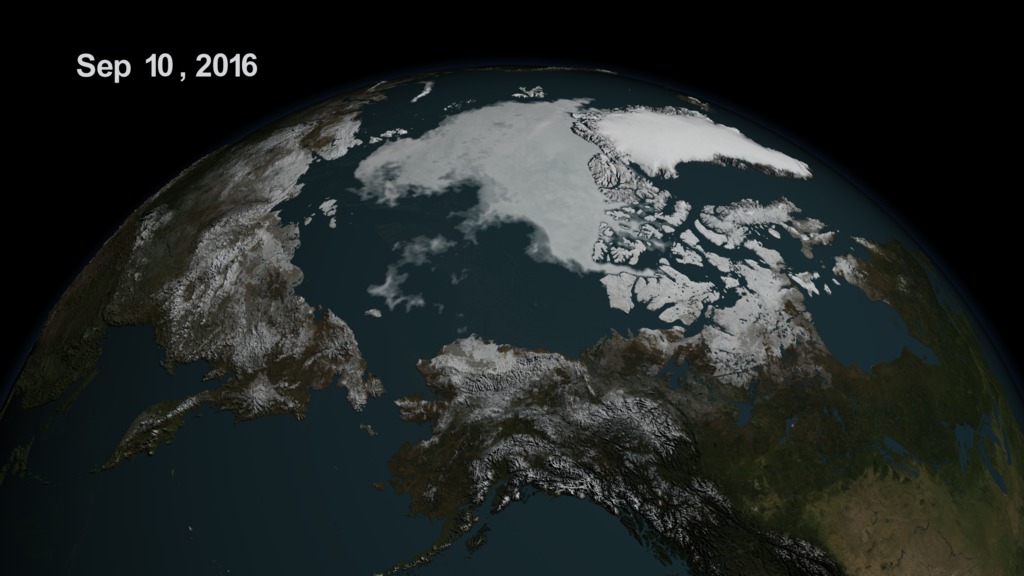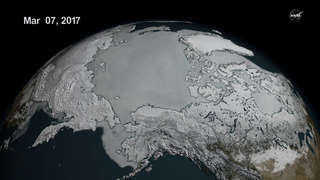Earth
ID: 4564
This animation shows the seasonal change in the extent of the Arctic sea ice between the Arctic minimum, September 10, 2016, and Arctic maximum on March 7, 2017.
Arctic sea ice appears to have reached a record low wintertime maximum extent, according to scientists at NASA and the NASA-supported National Snow and Ice Data Center (NSIDC) in Boulder, Colo. This winter, a combination of warmer-than-average temperatures, winds unfavorable to ice expansion, and a series of storms halted sea ice growth in the Arctic. This year’s maximum extent, reached on March 7 at 5.57 million square miles (14.42 million square kilometers), is only about 40,000 square miles below the previous record low, which occurred in 2016,
The images shown here portray the sea ice as it was observed by the AMSR2 instrument onboard the Japanese Shizuku satellite. The opacity of the sea ice is derived from the AMSR2 sea ice concentration. The blueish white color of the sea ice is derived from the AMSR2 89 GHz brightness temperature. The annual cycle starts with the minimum extent reached on August 31, 2016 and runs through the daily sea ice concentration until the maximum occurs on March 3, 2017. The Arctic’s sea ice maximum extent has dropped by an average of 2.8 percent per decade since 1979, the year satellites started measuring sea ice. The summertime minimum extent losses are nearly five times larger: 13.5 percent per decade. Besides shrinking in extent, the sea ice cap is also thinning and becoming more vulnerable to the action of ocean waters, winds and warmer temperatures.

Arctic Daily Sea Ice Concentration from Arctic Minimum 2016 to Arctic Maximum 2017
Arctic sea ice appears to have reached a record low wintertime maximum extent, according to scientists at NASA and the NASA-supported National Snow and Ice Data Center (NSIDC) in Boulder, Colo. This winter, a combination of warmer-than-average temperatures, winds unfavorable to ice expansion, and a series of storms halted sea ice growth in the Arctic. This year’s maximum extent, reached on March 7 at 5.57 million square miles (14.42 million square kilometers), is only about 40,000 square miles below the previous record low, which occurred in 2016,
The images shown here portray the sea ice as it was observed by the AMSR2 instrument onboard the Japanese Shizuku satellite. The opacity of the sea ice is derived from the AMSR2 sea ice concentration. The blueish white color of the sea ice is derived from the AMSR2 89 GHz brightness temperature. The annual cycle starts with the minimum extent reached on August 31, 2016 and runs through the daily sea ice concentration until the maximum occurs on March 3, 2017. The Arctic’s sea ice maximum extent has dropped by an average of 2.8 percent per decade since 1979, the year satellites started measuring sea ice. The summertime minimum extent losses are nearly five times larger: 13.5 percent per decade. Besides shrinking in extent, the sea ice cap is also thinning and becoming more vulnerable to the action of ocean waters, winds and warmer temperatures.

Used Elsewhere In
Older Version
Related
Visualization Credits
Lori Perkins (NASA/GSFC): Lead Visualizer
Cindy Starr (Global Science and Technology, Inc.): Visualizer
Walt Meier (NASA/GSFC): Lead Scientist
Robert Gersten (Wyle Information Systems): Scientist
Kathryn Mersmann (USRA): Lead Producer
Laurence Schuler (ADNET Systems, Inc.): Project Support
Ian Jones (ADNET Systems, Inc.): Project Support
Claire Parkinson (NASA/GSFC): Lead Scientist
Jefferson Beck (USRA): Producer
Cindy Starr (Global Science and Technology, Inc.): Visualizer
Walt Meier (NASA/GSFC): Lead Scientist
Robert Gersten (Wyle Information Systems): Scientist
Kathryn Mersmann (USRA): Lead Producer
Laurence Schuler (ADNET Systems, Inc.): Project Support
Ian Jones (ADNET Systems, Inc.): Project Support
Claire Parkinson (NASA/GSFC): Lead Scientist
Jefferson Beck (USRA): Producer
Please give credit for this item to:
NASA's Goddard Space Flight Center Scientific Visualization Studio
The Blue Marble data is courtesy of Reto Stockli (NASA/GSFC).
Data Citation for Greenland DEM: Howat I.M., A. Negrete, T. Scambos, T. Haran, in prep, A high-resolution elevation model for the Greenland Ice Sheet from combined stereoscopic and photoclinometric data.
NASA's Goddard Space Flight Center Scientific Visualization Studio
The Blue Marble data is courtesy of Reto Stockli (NASA/GSFC).
Data Citation for Greenland DEM: Howat I.M., A. Negrete, T. Scambos, T. Haran, in prep, A high-resolution elevation model for the Greenland Ice Sheet from combined stereoscopic and photoclinometric data.
Short URL to share this page:
https://svs.gsfc.nasa.gov/4564
Missions:
Global Precipitation Measurement (GPM)
Terra
Data Used:
Note: While we identify the data sets used in these visualizations, we do not store any further details nor the data sets themselves on our site.
Keywords:
DLESE >> Cryology
SVS >> HDTV
GCMD >> Earth Science >> Cryosphere >> Sea Ice >> Sea Ice Concentration
GCMD >> Earth Science >> Oceans >> Sea Ice >> Sea Ice Concentration
SVS >> Hyperwall
NASA Science >> Earth
GCMD keywords can be found on the Internet with the following citation: Olsen, L.M., G. Major, K. Shein, J. Scialdone, S. Ritz, T. Stevens, M. Morahan, A. Aleman, R. Vogel, S. Leicester, H. Weir, M. Meaux, S. Grebas, C.Solomon, M. Holland, T. Northcutt, R. A. Restrepo, R. Bilodeau, 2013. NASA/Global Change Master Directory (GCMD) Earth Science Keywords. Version 8.0.0.0.0
https://svs.gsfc.nasa.gov/4564
Missions:
Global Precipitation Measurement (GPM)
Terra
Data Used:
GTOPO30 Topography and Bathymetry
Data Compilation - USGSTerra and Aqua/MODIS/Blue Marble: Next Generation also referred to as: BMNG
Credit:
The Blue Marble data is courtesy of Reto Stockli (NASA/GSFC).
The Blue Marble data is courtesy of Reto Stockli (NASA/GSFC).
Comiso's Daily Sea Ice Concentration
Data Compilation - NASA/GSFC - 09/10/2016 - 03/07/2017Terra and Aqua/MODIS/Land Cover
Greenland Mapping Project (GIMP) Digital Elevation Model also referred to as: GIMP Greenland DEM
Data Compilation - Courtesy of Ian Howat, OSUKeywords:
DLESE >> Cryology
SVS >> HDTV
GCMD >> Earth Science >> Cryosphere >> Sea Ice >> Sea Ice Concentration
GCMD >> Earth Science >> Oceans >> Sea Ice >> Sea Ice Concentration
SVS >> Hyperwall
NASA Science >> Earth
GCMD keywords can be found on the Internet with the following citation: Olsen, L.M., G. Major, K. Shein, J. Scialdone, S. Ritz, T. Stevens, M. Morahan, A. Aleman, R. Vogel, S. Leicester, H. Weir, M. Meaux, S. Grebas, C.Solomon, M. Holland, T. Northcutt, R. A. Restrepo, R. Bilodeau, 2013. NASA/Global Change Master Directory (GCMD) Earth Science Keywords. Version 8.0.0.0.0














